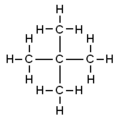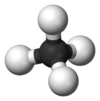Pentane
Topic: Chemistry
 From HandWiki - Reading time: 7 min
From HandWiki - Reading time: 7 min

| |||
|
| |||
| Names | |||
|---|---|---|---|
| Preferred IUPAC name
Pentane[2] | |||
| Other names
Quintane;[1] Refrigerant-4-13-0
| |||
| Identifiers | |||
3D model (JSmol)
|
|||
| 969132 | |||
| ChEBI | |||
| ChEMBL | |||
| ChemSpider | |||
| DrugBank | |||
| EC Number |
| ||
| 1766 | |||
| MeSH | pentane | ||
PubChem CID
|
|||
| RTECS number |
| ||
| UNII | |||
| UN number | 1265 | ||
| |||
| |||
| Properties[4] | |||
| C5H12 | |||
| Molar mass | 72.151 g·mol−1 | ||
| Appearance | Colourless liquid | ||
| Odor | Gasoline-like[3] | ||
| Density | 0.626 g/mL; 0.6262 g/mL (20 °C) | ||
| Melting point | −130.5 to −129.1 °C; −202.8 to −200.3 °F; 142.7 to 144.1 K | ||
| Boiling point | 35.9 to 36.3 °C; 96.5 to 97.3 °F; 309.0 to 309.4 K | ||
| 40 mg/L (20 °C) | |||
| log P | 3.255 | ||
| Vapor pressure | 57.90 kPa (20.0 °C) | ||
Henry's law
constant (kH) |
7.8 nmol Pa−1 kg−1 | ||
| Acidity (pKa) | ~45 | ||
| Basicity (pKb) | ~59 | ||
| UV-vis (λmax) | 200 nm | ||
| -63.05·10−6 cm3/mol | |||
Refractive index (nD)
|
1.358 | ||
| Viscosity | 0.240 mPa·s (at 20 °C) | ||
| Thermochemistry | |||
Heat capacity (C)
|
167.19 J K−1 mol−1 | ||
Std molar
entropy (S |
263.47 J K−1 mol−1 | ||
Std enthalpy of
formation (ΔfH⦵298) |
−174.1–−172.9 kJ mol−1 | ||
Std enthalpy of
combustion (ΔcH⦵298) |
−3.5095–−3.5085 MJ mol−1 | ||
| Hazards | |||
| GHS pictograms |    
| ||
| GHS Signal word | DANGER | ||
| H225, H304, H336, H411 | |||
| P210, P261, P273, P301+310, P331 | |||
| NFPA 704 (fire diamond) | |||
| Flash point | −49.0 °C (−56.2 °F; 224.2 K) | ||
| 260.0 °C (500.0 °F; 533.1 K) | |||
| Explosive limits | 1.5–7.8%[3] | ||
| Lethal dose or concentration (LD, LC): | |||
LD50 (median dose)
|
| ||
LC50 (median concentration)
|
130,000 mg/m3 (mouse, 30 min) 128,200 ppm (mouse, 37 min) 325,000 mg/m3 (mouse, 2 hr)[5] | ||
| NIOSH (US health exposure limits): | |||
PEL (Permissible)
|
TWA 1000 ppm (2950 mg/m3)[3] | ||
REL (Recommended)
|
TWA 120 ppm (350 mg/m3) C 610 ppm (1800 mg/m3) [15-minute][3] | ||
IDLH (Immediate danger)
|
1500 ppm[3] | ||
| Related compounds | |||
Related alkanes
|
|||
Except where otherwise noted, data are given for materials in their standard state (at 25 °C [77 °F], 100 kPa). | |||
| Infobox references | |||
Pentane is an organic compound with the formula C5H12—that is, an alkane with five carbon atoms. The term may refer to any of three structural isomers, or to a mixture of them: in the IUPAC nomenclature, however, pentane means exclusively the n-pentane isomer, in which case pentanes refers to a mixture of them; the other two are called isopentane (methylbutane) and neopentane (dimethylpropane). Cyclopentane is not an isomer of pentane because it has only 10 hydrogen atoms where pentane has 12.
Pentanes are components of some fuels and are employed as specialty solvents in the laboratory. Their properties are very similar to those of butanes and hexanes.
Isomers
| Common name | normal pentane unbranched pentane n-pentane |
isopentane | neopentane |
| IUPAC name | pentane | 2-methylbutane | 2,2-dimethylpropane |
| Molecular diagram | 
|

|

|
| Skeletal diagram | 
|

| |
| Melting point (°C)[6] | −129.8 | −159.9 | −16.6 |
| Boiling point (°C)[6] | 36.0 | 27.7 | 9.5 |
| Density (0 °C,kg/m3)[6] |
621 | 616 | 586 |
Industrial uses
Pentanes are some of the primary blowing agents used in the production of polystyrene foam and other foams. Usually, a mixture of n-, i-, and increasingly cyclopentane is used for this purpose.
Acid-catalyzed isomerization gives isopentane, which is used in producing high-octane fuels.[7]
Because of their low boiling points, low cost, and relative safety, pentanes are used as a working medium in geothermal power stations and organic Rankine cycles. It is also used in some blended refrigerants.
Pentanes are solvents in many ordinary products, e.g. in some pesticides.[8]
Laboratory use
Pentanes are relatively inexpensive and are the most volatile liquid alkanes at room temperature, so they are often used in the laboratory as solvents that can be conveniently and rapidly evaporated. However, because of their nonpolarity and lack of functionality, they dissolve only nonpolar and alkyl-rich compounds. Pentanes are miscible with most common nonpolar solvents such as chlorocarbons, aromatics, and ethers.
They are often used in liquid chromatography.
Physical properties
The boiling points of the pentane isomers range from about 9 to 36 °C. As is the case for other alkanes, the more thickly branched isomers tend to have lower boiling points.
The same tends to be true for the melting points of alkane isomers, and that of isopentane is 30 °C lower than that of n-pentane. However, the melting point of neopentane, the most heavily branched of the three, is 100 °C higher than that of isopentane. The anomalously high melting point of neopentane has been attributed to the tetrahedral molecules packing more closely in solid form; this explanation is contradicted by the fact that neopentane has a lower density than the other two isomers,[9] and the high melting point is actually caused by neopentane's significantly lower entropy of fusion.
The branched isomers are more stable (have lower heat of formation and heat of combustion) than n-pentane. The difference is 1.8 kcal/mol for isopentane, and 5 kcal/mol for neopentane.[10][11]
Rotation about two central single C-C bonds of n-pentane produces four different conformations.[12]
Reactions
Like other alkanes, pentanes are largely unreactive at standard room temperature and conditions - however, with sufficient activation energy (e.g., an open flame), they readily oxidize to form carbon dioxide and water:
- C5H12 + 8 O2 → 5 CO2 + 6 H2O + heat/energy
Like other alkanes, pentanes undergo free radical chlorination:
- C5H12 + Cl2 → C5H11Cl + HCl
Such reactions are unselective; with n-pentane, the result is a mixture of the 1-, 2-, and 3-chloropentanes, as well as more highly chlorinated derivatives. Other radical halogenations can also occur.
Production and occurrence
Pentane is produced by fractional distillation of petroleum and purified by rectification (successive distillations).[13]
It occurs in alcoholic beverages and in hop oil.[13] It is a component of exhaled breath for some individuals. A degradation product of unsaturated fatty acids, its presence is associated with some diseases and cancers.[14]
References
- ↑ Hofmann, August Wilhelm Von (1 January 1867). "I. On the action of trichloride of phosphorus on the salts of the aromatic monamines". Proceedings of the Royal Society of London 15: 54–62. doi:10.1098/rspl.1866.0018.
- ↑ International Union of Pure and Applied Chemistry (2014). Nomenclature of Organic Chemistry: IUPAC Recommendations and Preferred Names 2013. The Royal Society of Chemistry. p. 59. doi:10.1039/9781849733069. ISBN 978-0-85404-182-4.
- ↑ 3.0 3.1 3.2 3.3 3.4 NIOSH Pocket Guide to Chemical Hazards. "#0486". National Institute for Occupational Safety and Health (NIOSH). https://www.cdc.gov/niosh/npg/npgd0486.html.
- ↑ Record of n-Pentane in the GESTIS Substance Database of the Institute for Occupational Safety and Health, accessed on 19 April 2011.
- ↑ "n-Pentane". Immediately Dangerous to Life and Health Concentrations (IDLH). National Institute for Occupational Safety and Health (NIOSH). https://www.cdc.gov/niosh/idlh/109660.html.
- ↑ 6.0 6.1 6.2 James Wei (1999), Molecular Symmetry, Rotational Entropy, and Elevated Melting Points. Ind. Eng. Chem. Res., volume 38 issue 12, pp. 5019–5027 doi:10.1021/ie990588m
- ↑ Karl Griesbaum; Arno Behr; Dieter Biedenkapp; Heinz-Werner Voges; Dorothea Garbe; Christian Paetz; Gerd Collin; Dieter Mayer et al. (2002). Ullmann's Encyclopedia of Industrial Chemistry. Weinheim: Wiley-VCH. doi:10.1002/14356007.a13_227. ISBN 978-3-527-30673-2.
- ↑ Milne, G. W. A., ed (2005). Gardner's Commercially Important Chemicals: Synonyms, Trade Names, and Properties. Hoboken, New Jersey: John Wiley & Sons, Inc. p. 477. ISBN 978-0-471-73518-2.
- ↑ Wei, James (1999). "Molecular Symmetry, Rotational Entropy, and Elevated Melting Points". Industrial & Engineering Chemistry Research (American Chemical Society (ACS)) 38 (12): 5019–5027. doi:10.1021/ie990588m. ISSN 0888-5885.
- ↑ From the values listed at Standard enthalpy change of formation (data table).
- ↑ Good, W.D (1970). "The enthalpies of combustion and formation of the isomeric pentanes". The Journal of Chemical Thermodynamics (Elsevier BV) 2 (2): 237–244. doi:10.1016/0021-9614(70)90088-1. ISSN 0021-9614.
- ↑ Roman M. Balabin (2009). "Enthalpy Difference between Conformations of Normal Alkanes: Raman Spectroscopy Study of n-Pentane and n-Butane". J. Phys. Chem. A 113 (6): 1012–9. doi:10.1021/jp809639s. PMID 19152252. Bibcode: 2009JPCA..113.1012B.
- ↑ 13.0 13.1 "Pentane". https://pubchem.ncbi.nlm.nih.gov/compound/Pentane.
- ↑ Phillips, Michael; Herrera, Jolanta; Krishnan, Sunithi; Zain, Mooena; Greenberg, Joel; Cataneo, Renee N. (1999). "Variation in volatile organic compounds in the breath of normal humans". Journal of Chromatography B: Biomedical Sciences and Applications 729 (1–2): 75–88. doi:10.1016/S0378-4347(99)00127-9. PMID 10410929.
External links
- International Chemical Safety Card 0534 at ILO.org
- NIOSH Pocket Guide to Chemical Hazards at CDC.gov
- Phytochemical data for pentane at Ars-grin.gov
 |
 KSF
KSF









